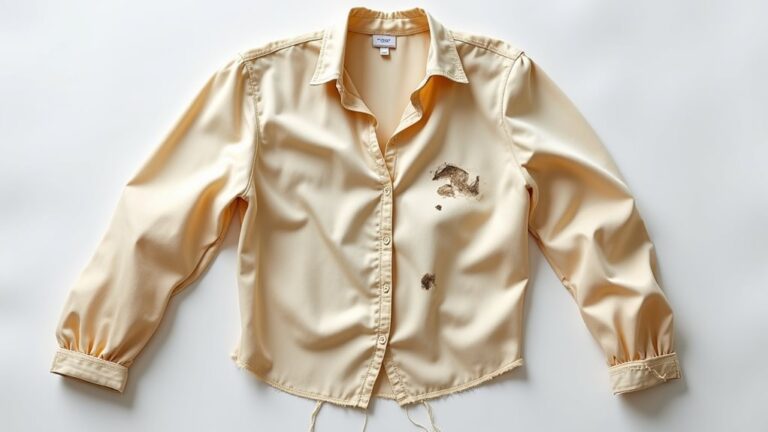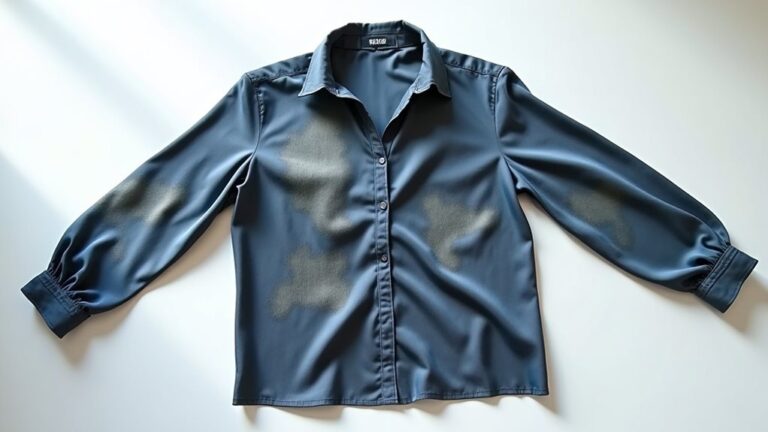When you’re at the dry cleaner deciding whether to add starch, you’re choosing between crisp formality and natural comfort—starch creates that professional, structured look by forming a protective layer that repels dirt and evens wrinkles, though it works best on cotton and linen rather than delicate fabrics like silk or cashmere. While light starch offers polish without stiffness, heavy applications can irritate sensitive skin and weaken fibers over time, and honestly, modern professionals increasingly prefer the softer, lived-in feel that matches today’s relaxed workplace culture—though understanding the full picture helps you make smarter choices.
What Is Starch and How Does It Work
When I first discovered starch in my grandmother’s laundry room, tucked between bottles of bleach and fabric softener, I honestly thought it was some relic from the 1950s that she’d forgotten to throw away 😅.
Turns out, starch is actually a plant-based compound that’s been helping people achieve crisp, professional-looking clothes since ancient Egyptian times.
When you mix starch with warm water, it creates this thick, sticky paste that works like magic on your garments. The starch forms a protective layer over your fabric fibers, which keeps dirt and sweat from penetrating deep into the material while making wrinkles practically disappear.
The starch forms a protective barrier that repels dirt and sweat while smoothing out wrinkles like magic.
It’s particularly fantastic for cotton and linen pieces that need that extra bit of structure and polish.
Benefits of Using Starch in Dry Cleaning
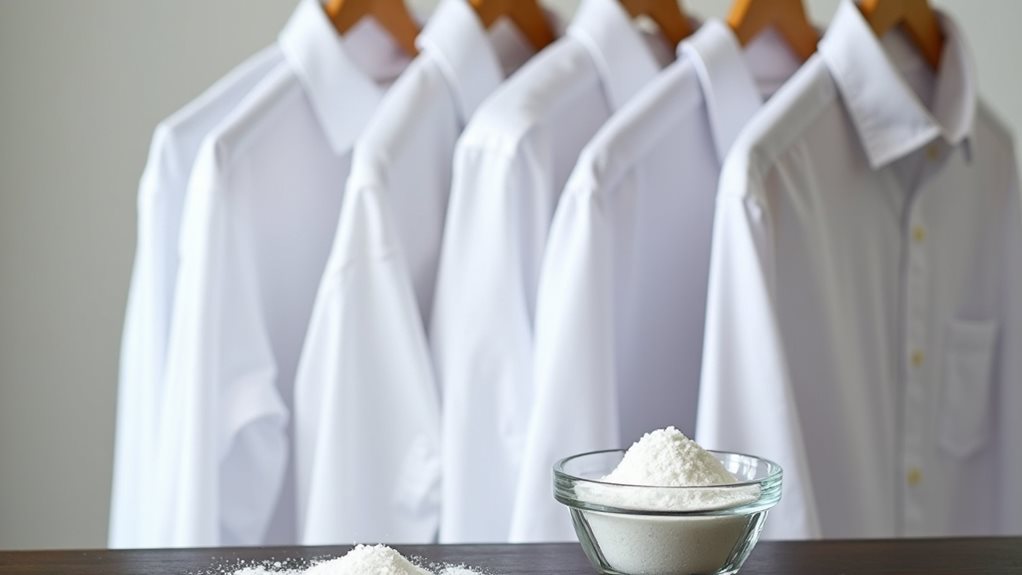
Now that you understand how starch creates that protective barrier on your clothes, you’ll probably want to know why dry cleaners swear by this seemingly simple ingredient.
Here’s the thing—starch isn’t just about making your shirts look crisp (though it definitely does that!). When your cleaner applies starch, they’re actually making your life easier in ways you mightn’t expect.
That sleek surface means less wrestling with wrinkles during ironing, and honestly, who doesn’t want that? Plus, starch acts like a dirt magnet, pulling sweat and grime away from fabric fibers, which keeps your clothes fresher longer.
You can even choose light, medium, or heavy starch levels based on your preference—it’s like having a personal armor for your wardrobe.
Potential Drawbacks and Considerations
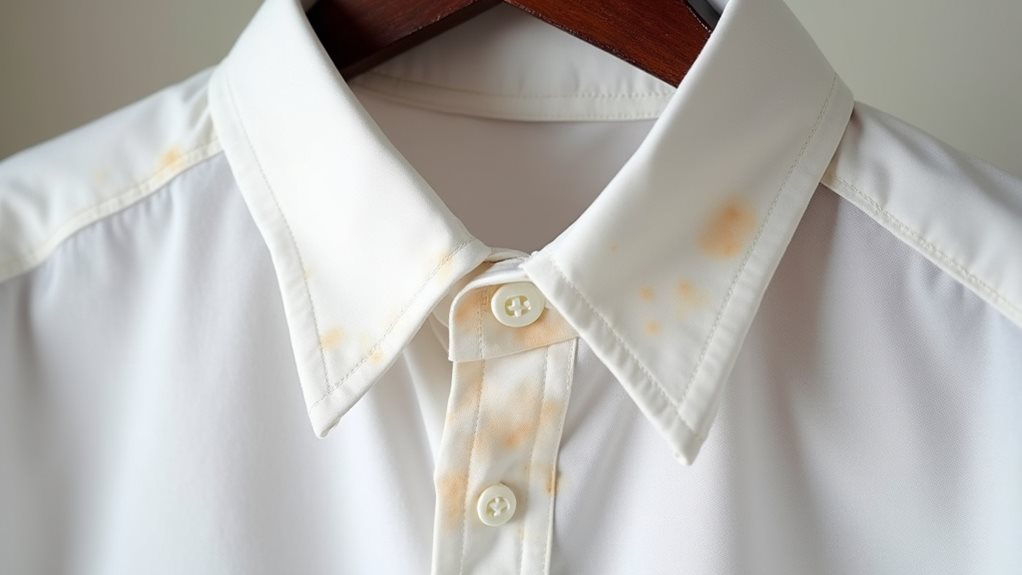
While starch can work wonders for your wardrobe, I’d be doing you a disservice if I didn’t share some real talk about its potential downsides—because trust me, I’ve learned these lessons the hard way!
Over time, starch buildup can actually weaken fabric fibers, leading to premature fraying and thread breakage that’ll have you replacing favorite shirts sooner than expected.
If you’ve got sensitive skin, heavy starch applications might cause irritation, so definitely communicate your preferences to your dry cleaner.
Plus, certain delicate fabrics like silk and cashmere simply can’t handle starch treatment without damage.
Ironically, too much starch can even trap dirt and sweat, making future stain removal more challenging—the opposite of what we’re trying to achieve! 😅
When starch does create stubborn buildup stains, chemical solvents used in professional dry cleaning are typically your best bet for removal since they’re specifically designed to break down these types of residues.
Starch Application Levels: Light, Medium, and Heavy
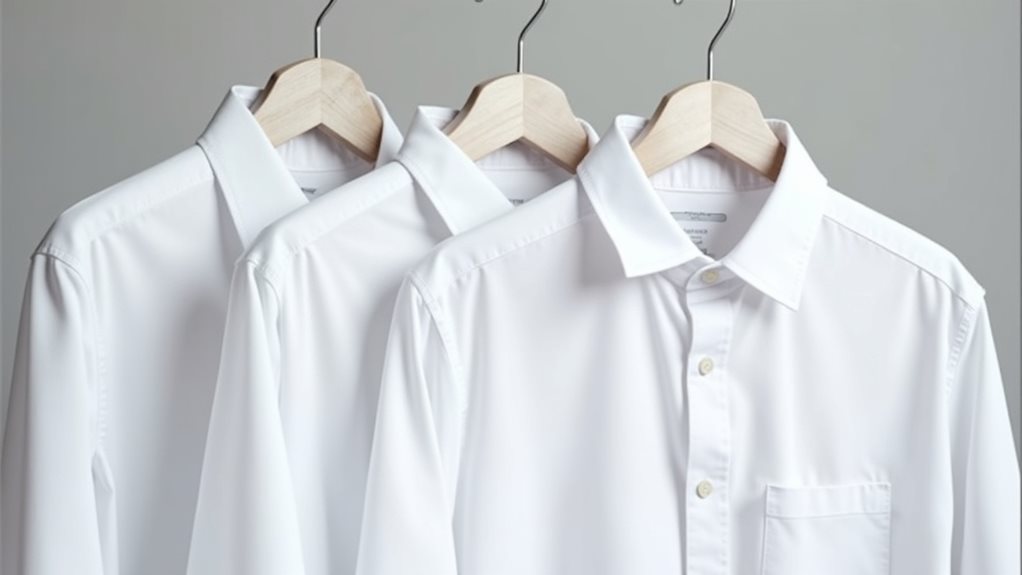
The spectrum of starch intensity reminds me of ordering coffee—you’ve got your light roast folks who want just a hint of that crisp feeling, your medium roast enthusiasts seeking the perfect balance, and those bold souls who go full espresso with heavy starch that could practically stand up on its own!
Light starch gives you that professional appearance while keeping comfort intact, plus it’ll help your clothes last longer.
Light starch delivers that crisp, professional look while keeping your clothes comfortable and extending their lifespan.
Medium starch strikes that sweet spot for office wear, delivering polish without feeling like you’re wearing cardboard.
Heavy starch creates serious structure—perfect for suits when you want to look like you mean business.
Always chat with your dry cleaner about preferences, especially with delicate fabrics.
Fabrics That Should Avoid Starch Treatment
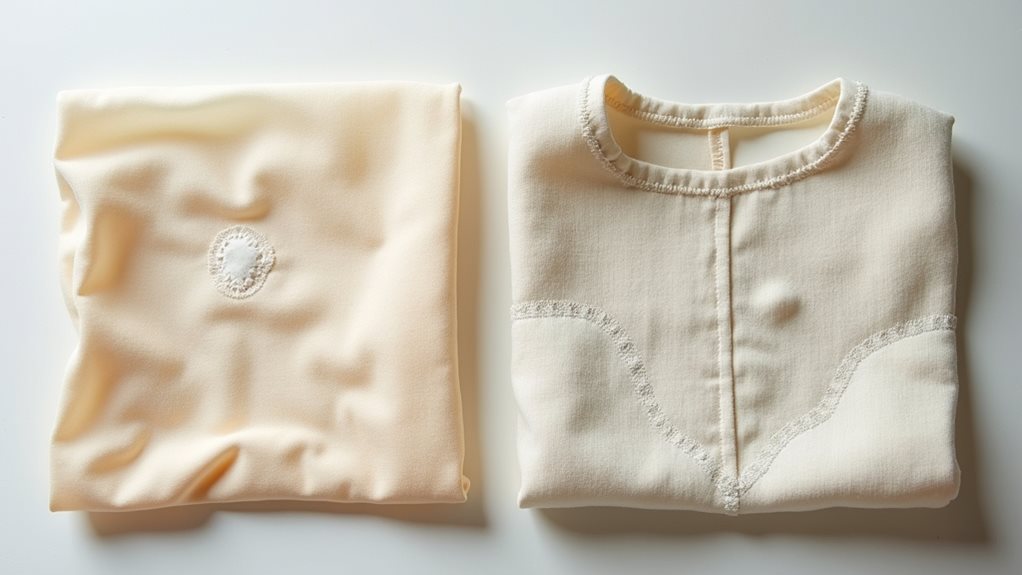
You’ll want to steer clear of starch when dealing with delicate synthetic fabrics like polyester and nylon, as I learned the hard way when my favorite workout shirt turned into what felt like cardboard after an overzealous starch application 😅.
Natural luxury fibers such as cashmere and silk deserve special care too, since starch can strip away their inherent softness and flexibility, turning your expensive investment into something that feels more like sandpaper than silk.
Wool and wool blends also fall into this avoid-at-all-costs category, because starch tends to make these fibers brittle and prone to fraying, which means your cozy sweater could end up looking like it survived a battle with a pair of scissors.
Similarly, beaded or sequined garments should never receive starch treatment, as the combination of starch’s stiffening agents and the weight of embellishments can cause decorative elements to pull away from the fabric or create permanent creasing around delicate details.
Delicate Synthetic Fabrics
Several fabric types will rebel against starch treatment like a teenager resists curfew, and knowing which ones can save you from costly mistakes that I’ve unfortunately made myself.
Delicate synthetic fabrics like polyester and nylon are particularly finicky when it comes to dry cleaning starch applications, and I learned this the hard way with my favorite dress shirt 😅.
These materials become stiff and uncomfortable after starch treatment, completely losing their natural drape and flexible feel that makes them so appealing.
The starch fundamentally fights against the fabric’s inherent properties, creating an unnatural rigidity that compromises both comfort and appearance.
Instead of forcing starch onto these synthetics, work with your dry cleaner to use fabric sizing alternatives that’ll maintain structure without sacrificing the material’s delicate characteristics.
Natural Luxury Fibers
While synthetic fabrics present their own challenges, natural luxury fibers like cashmere, silk, and wool demand even more careful consideration when it comes to starch treatments, and I’ve witnessed some heartbreaking disasters that could’ve been easily prevented.
Your precious cashmere sweater can become stiff and lose its cloud-like softness, while silk blouses may develop unsightly discoloration that’s impossible to reverse.
I learned this lesson the hard way when my favorite wool blazer lost its natural drape after an overzealous starch application 😅.
Most experienced dry cleaners will recommend fabric sizing instead, which maintains that luxurious feel without compromising the fiber’s integrity.
The chemical solvents used in dry cleaning are specifically designed to preserve the structure and texture of these delicate materials without the harsh effects that water-based treatments can cause.
Trust me, protecting these investment pieces is worth having that conversation upfront.
Wool and Blends
Though wool might seem sturdy enough to handle any treatment, it’s actually one of the most vulnerable fabrics when it comes to starch applications, and I’ve seen too many beautiful garments transformed into cardboard-like disappointments.
When wool gets dry cleaned with starch, it loses that gorgeous natural drape and becomes unnaturally stiff, compromising the very qualities that make wool special. The starch interferes with wool’s breathability and can cause shrinkage or shape distortion – imagine your favorite sweater turning into an unwearable sculpture! 😅
Wool blends face similar risks, and even luxurious synthetic cashmere can degrade under starch treatment. Always communicate your fabric type to your dry cleaner, because protecting wool’s natural softness requires avoiding starch entirely.
Unlike traditional washing methods that use water and can damage delicate fibers, chemical solvents in dry cleaning are specifically designed to preserve wool’s integrity without the harsh effects of starch treatments.
Health and Safety Aspects of Starch Use

When it comes to your health and safety, starch in dry cleaning sits comfortably in the “generally safe” category, much like that reliable friend who’s never caused drama but still deserves a thoughtful conversation.
Most folks can use starch without worry, and the dry cleaning industry has adopted it for decades without notable health red flags.
However, if you’ve got sensitive skin that throws tantrums over new products, here’s what you should know:
- Test first – Ask your cleaner for a small trial area before starching your entire wardrobe
- Communicate openly – Share any skin concerns with your dry cleaner to explore gentler alternatives
- Watch for fabric damage – Over-starching can weaken fibers, causing breakage that affects garment longevity
Smart cleaning clothes choices protect both you and your investment! 😊
Modern Alternatives and Changing Preferences
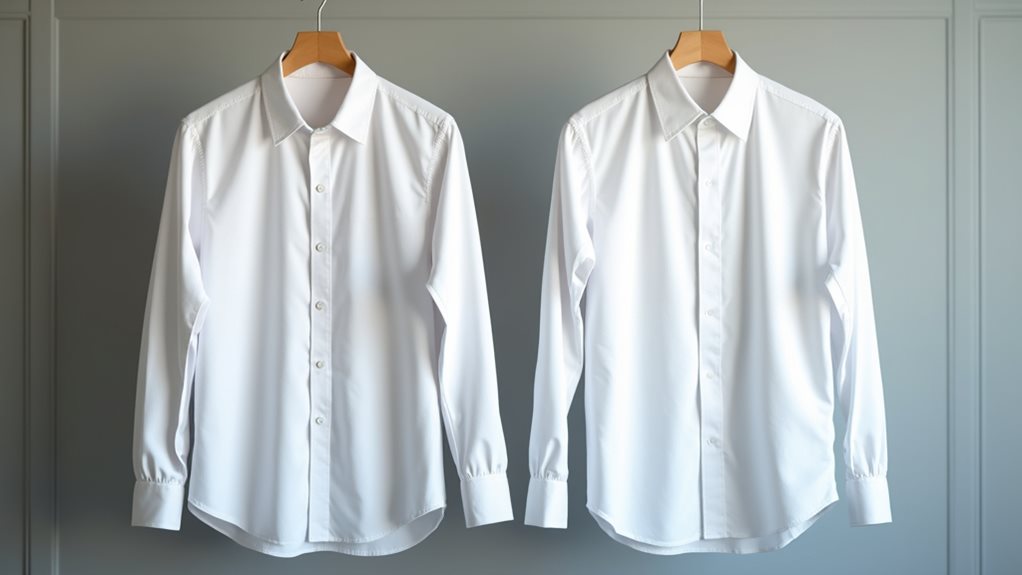
You’ve probably noticed how your favorite button-down shirts don’t need that stiff, boardroom-ready finish anymore, and honestly, I’m right there with you preferring the softer, lived-in feel over that cardboard-like crispness our parents insisted was “professional.”
The fabric revolution has basically turned the clothing world upside down, giving us wrinkle-resistant materials that laugh in the face of traditional starching, while workplaces have quietly evolved to adopt a more relaxed, human approach to dressing.
It’s fascinating how we’ve collectively decided that comfort trumps that old-school armor-like stiffness, though I’ll admit there’s still something nostalgic about watching my dry cleaner’s face when I specifically request “no starch, please” 😊.
This shift away from heavy starching also allows the chemical solvents used in dry cleaning to better preserve the natural drape and feel of quality fabrics without adding unnecessary stiffness.
Non-Iron Fabric Revolution
As someone who’s watched my own relationship with clothing evolve over the decades, I can tell you that the rise of non-iron fabrics has quietly revolutionized how we think about garment care and comfort.
You’ve probably noticed how these innovative materials have made starch feel like a relic from your grandmother’s laundry room, and honestly, that’s not entirely wrong.
Here’s what’s driving this fabric revolution:
- Busy professionals are choosing wrinkle-resistant materials that save precious morning minutes.
- Comfort-focused consumers prefer the natural drape of untreated fabrics over stiff, starched alternatives.
- Practical shoppers gravitate toward durable, low-maintenance options that simplify their lives.
This shift means traditional dry cleaners are adapting their services, moving away from heavy starch applications toward preserving these fabrics’ inherent wrinkle-fighting properties.
While dry cleaning remains important for specialty items and formal wear, many everyday garments can now be maintained through simple home washing thanks to these fabric innovations.
Comfort Over Tradition
This fabric revolution reflects something deeper happening in our closets and, frankly, in our lives—we’re choosing comfort over the rigid expectations that once defined “proper” dressing.
You’ve probably noticed this shift yourself, trading those starch-stiffened collars for softer alternatives that don’t feel like cardboard against your neck. Modern fabrics maintain their shape without that artificial crispness, and honestly, don’t you feel more confident when you’re comfortable?
The younger generation especially accepts this change, understanding that professionalism doesn’t require sacrificing physical ease. While grandpa might’ve insisted on heavy starch for every business meeting, today’s workplace values authenticity over armor-like attire.
Your garments can look polished without feeling like a straightjacket, proving that sometimes evolution means choosing what feels right over what tradition dictates. Professional dry cleaning services now accommodate these preferences by offering eco-friendly alternatives that maintain fabric integrity without the harsh chemical treatments of the past.
Professional Standards Evolution
When offices started embracing “business casual” a few decades ago, nobody predicted how dramatically it would reshape our relationship with starched clothing, but here we are, watching crisp collars become as outdated as fax machines.
Today’s professional standards have evolved beyond the rigid expectations our parents faced, and honestly, it’s invigorating to see comfort finally getting its due respect in boardrooms across America.
Here’s how modern professionals are redefining workplace attire:
- Performance fabrics that maintain structure without starch’s stiffness
- Wrinkle-resistant materials that look polished straight from the closet
- Sustainable alternatives that align with eco-conscious values
You don’t need to sacrifice professionalism for comfort anymore – contemporary dress codes recognize that confidence comes from feeling good in your clothes, not from armor-like starch that makes you walk like a robot! 😊
The dry cleaning industry itself is responding to these changing preferences by adopting eco-friendly cleaning alternatives that offer the same garment care without the environmental impact of traditional chemicals.



